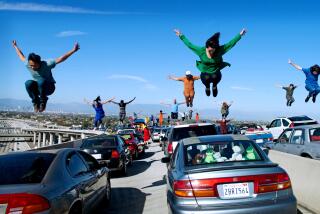Dreaming of a Greener L.A.
Years ago it seemed an impossible dream: to hike from Will Rogers Park in Pacific Palisades all the way to Point Mugu State Park in Ventura County. When Congress created the Santa Monica Mountains National Recreation Area in 1978, the park was little more than hopeful green lines superimposed over a map dotted with large tracts of private property and hillside homes. Now the 60-mile Backbone Trail through the park is a reality, and local parkland visionaries are focusing on a new dream, Los Angeles Mayor James K. Hahn’s goal of a park within walking distance of every city resident. That may be a harder trick than constructing the Backbone Trail.
Thanks for the trail goes to platoons of hot, sweaty trail diggers who, over the years, have cleared the snaking path on steep mountainsides. Thanks, also, to those who toiled in the halls of government, shaking loose money for property purchases and crucial rights of way. With the last six miles or so to be completed in the next few years, hikers can tramp through seemingly remote wilderness just a short drive from busy city streets.
Now, another dream arises: to provide decent recreational space where people live. Professor Jennifer Wolch and her colleagues at USC’s Sustainable Cities Program use a series of maps to graphically illustrate just how little space there is to kick a soccer ball, dig in a sandbox or just lie in the grass, particularly in the poorest, densest parts of town.
It’s old news, of course, that Los Angeles has less parkland per resident than most other major cities. Even more troubling is the distribution of parks. In the city’s central and Eastside neighborhoods, Wolch found that less than one-third of the population lives within a quarter-mile of a park, and nearly 73% of children--many in apartments with no yards--have no play space nearby.
But there are hopeful signs. Hahn announced last month that the city has joined with the nonprofit Trust for Public Land to identify bits of ignored land that public agencies and nonprofit groups could turn into parks. Abandoned lots and even trashed-up alleys could qualify.
At the same time, a group of city officials and local advocates is working on an urban land trust that could develop and manage the new patches of green. The trust concept has worked well in Baltimore, Chicago and other cities. Finally, the city and the Los Angeles Unified School District are designing new schools so that neighbors would be able to use the new athletic fields, gyms and auditoriums in off-hours.
This burst of creative thinking could turn green dreams into reality. It worked for the “impossible” Backbone Trail. It can work in Los Angeles.
More to Read
Sign up for The Wild
We’ll help you find the best places to hike, bike and run, as well as the perfect silent spots for meditation and yoga.
You may occasionally receive promotional content from the Los Angeles Times.






